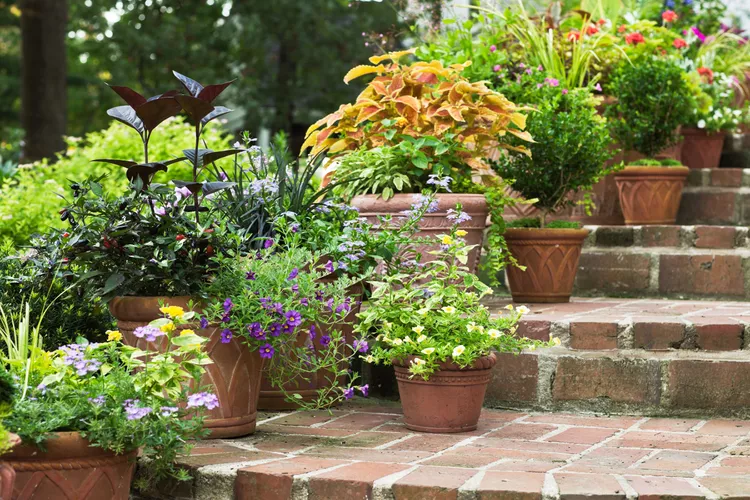Container gardening for beginners can seem a little daunting at first. What can you grow in a container? Where should you put your container garden? And how big of a container do you need? Whether you want to plant window boxes to dress up your home’s exterior or grow seasonal planters on your patio, these tips on container gardening for beginners will ensure a lush, successful experience.
What Plants to Grow in Containers
Vegetables, annual and perennial flowers, herbs, ornamental shrubs, and even trees can be grown in containers.
With container gardening, you can venture outside your hardiness zone. Perennials that wouldn’t survive in-ground in your area can be brought inside to overwinter and be enjoyed again next year. Even citrus trees can be successfully grown in large pots.
For flowers, follow the advice of using a thriller, a filler, and a spiller when planning your pots. Vegetables can follow the same pattern; pair tomato and thyme plants with a cucumber spilling over the side.
When growing large plants like tomatoes in containers, choose a compact or bushy variety to keep them tidy and manageable.
Container Gardening Tips for Beginners
Growing in containers is easy and affordable, but here are a few keys to success when creating any container garden.
1. Use the right potting mix.
The pros sometimes mix their own potting soil, but leave that to them if you are a beginner and purchase a high-quality bagged mix. Look for one specifically designed for containers; it usually has perlite, compost, and other materials to keep the mix loose and aerated.
Bargain-priced bagged soil is often of low quality, and your plants will suffer. You can’t get the season back and do it over, so this is the area to spend a few dollars more to get it right.
2. Never use soil from your yard.
Although plenty of plants grow fine in your garden’s soil, that doesn't mean it will work well in containers. Garden soil compacts quickly in the confines of a container and with frequent watering. Compacted soil doesn’t drain well, is hard for roots to penetrate, and suffers poor aeration (yes, roots need to breathe). Stick to potting mix designed for containers.
3. Drainage is a must.
Lack of drainage is a close second to poor soil as the top reason container plantings fail. Some pots don’t have drainage holes. DIY pots or containers—like that old watering can you bought at the flea market—often need to have holes drilled in them before using them as a planter.
Excess water that stays in the root zone means plant roots can’t breathe–they need oxygen too. Soggy soil also creates anaerobic conditions, which foster harmful bacteria and kill off the helpful ones. Too much moisture in the soil over extended periods often causes root rot.
4. Don't add rocks to the bottom.
A popular garden myth goes that adding a layer of rocks, broken pieces of pottery, or other coarse material will help drainage. While it seems logical, studies have proven that in most cases, this doesn’t work and may even slow down drainage.
5. The correct pot size matters.
Most plants in containers are limited by the pot size. A tomato variety planted in a 3-gallon pot grows much larger than the same variety planted in a 6-inch container. To get that lush and full look and help your plants thrive, match the pot to the mature size of the plant, not the tiny seedling you bought at the garden center.
- 5 gallon or larger: Tomatoes, peppers, ornamental shrubs, and container gardens with multiple types of plants
- 2-3 gallon size: herb plantings, many flowers like begonias, salvia, and short ornamental grasses
- 1 gallon or less: marigolds and other small annual flowers, lettuces, and accent plantings of a single small plant.
6. Place plants with similar needs together.
If you plan a multi-species pot, ensure the plants you select thrive in the same conditions. Most commonly, that means planting sun-loving plants together and not mixing them in the same container with shade-loving plants.
7. Don’t forget to water.
Soil mix in containers drains more quickly than in-ground soil, and the smaller volume of soil in the pot means the plant will use up available water faster. Large potted plants often need to be watered daily in the summer heat. To check, stick your finger an inch or two (up to the main knuckle) in the soil and feel if it is dry. If it is, it’s time to water. Water thoroughly; don’t just wet the surface.
8. Provide fertilizer.
Depending on the soil you use when planting, you may need to add fertilizer throughout the season. Some potting mixes come with slow-release fertilizer, and others don’t. If you forgot to check and have already thrown away the bag, don’t worry. Any general-purpose organic fertilizer is acceptable to add. Follow the directions on the package and water it in.
9. Support larger plants.
As in a garden bed, tall plants may need some staking or support to help them withstand wind and heavy rains or keep them from tipping over. Containers can be located next to a deck railing, trellis, or fence for support. A little twine tied loosely around the stems and to the rail is often all they need.
10. Pay attention to sun and shade.
Many plants thrive in full sun, but others scorch and burn. The sun’s position in the sky changes throughout the summer, and your sun or shade areas may change, too. You may need to relocate a pot that is getting too much sun or not enough.
Large containers filled with potting soil and plants can be challenging to move. Look for containers with wheels or a wheeled plant caddy to simplify the process.




















